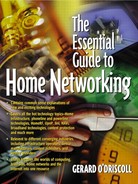COMPONENTS AND MANAGEMENT
The HAVi architecture is based on the IEEE 1394 standard, so you need to install specialized cables to interconnect in-home appliances. HAVi classifies appliances into the following categories:
Full A/V devices (FAV)— A FAV device contains a complete set of software elements comprising the HAVi architecture. This type of appliance generally has a rich set of hardware resources and is capable of supporting a complex software environment. A complete description of the myriad of software elements that are supported by FAVs is included in the next section of this chapter.
Intermediate A/V devices (IAV)— These types of electronic appliances are generally lower in cost than FAV appliances and have more limited resources. They do not provide a runtime environment for Java bytecode and so cannot act as controllers for devices within the home network.
Base A/V devices (BAV)— A BAV does not host the HAVi middleware software. Rather it hosts a Java-based control module that can be uploaded to any FAV device in the home network. This mechanism allows device vendors to continually innovate and improve their devices without forcing other vendors to track new features. When the new BAV device is plugged into the home network, the FAV that will control it simply uploads and runs the control module and needs not care about the actual internal details. In other words, BAV devices, via the upload model, are future-proof.
Legacy A/V devices (LAV)— The transition of stand-alone consumer electronic devices to networked devices is going to be slow and gradual. HAVi acknowledges this fact and supports all legacy consumer electronic devices—that is, appliances that were built before the advent of the HAVi networking standard. These appliances use proprietary protocols and standards for their control. These devices can work on an in-house network, but they require a FAV or an IAV to act as a gateway. In the context of a HAVi network, a gateway is used to translate HAVi commands to and from the legacy command control.
Rather than trying to remember all these acronyms, HAVi appliances can also be categorized according to the degree to which they support the 1394 standard:
Non-1394-based appliances
Appliances that use 1394 but do not support the HAVi architecture
Appliances that use 1394 and support HAVi
Currently, most of the appliances we have in our houses fall into the first category.
Now that we have described the physical components of a basic HAVi network, let's examine the system that is used to control or manage these appliances. The model used by HAVi to manage an in-home network makes a distinction between controllers and controlled appliances.
A controller is an application that acts as a host for controlled appliances. In terms of a HAVi environment, a host has the required hardware resources to store data and home networking software applications.
As the name suggests, a controller manages a controlled appliance.
For instance, an intelligent television in a family room might be the controller for a number of appliances around the house. The television could contain a particular software program that builds a user interface for controlled appliances. When family members want to interact with one of the controlled appliances, such as a mobile phone, the controller (the television in this case) will build and present the family member with a customized user interface.
